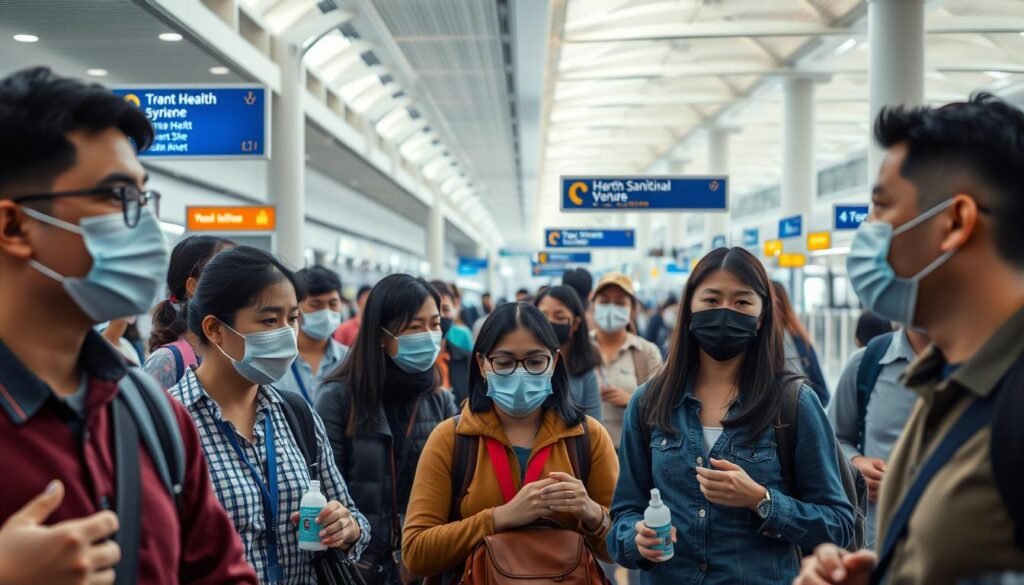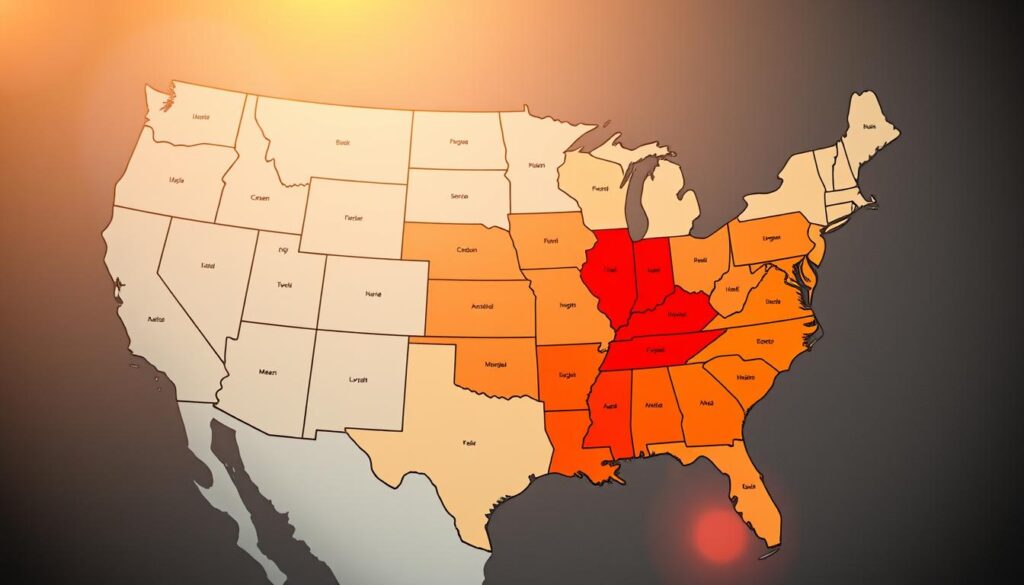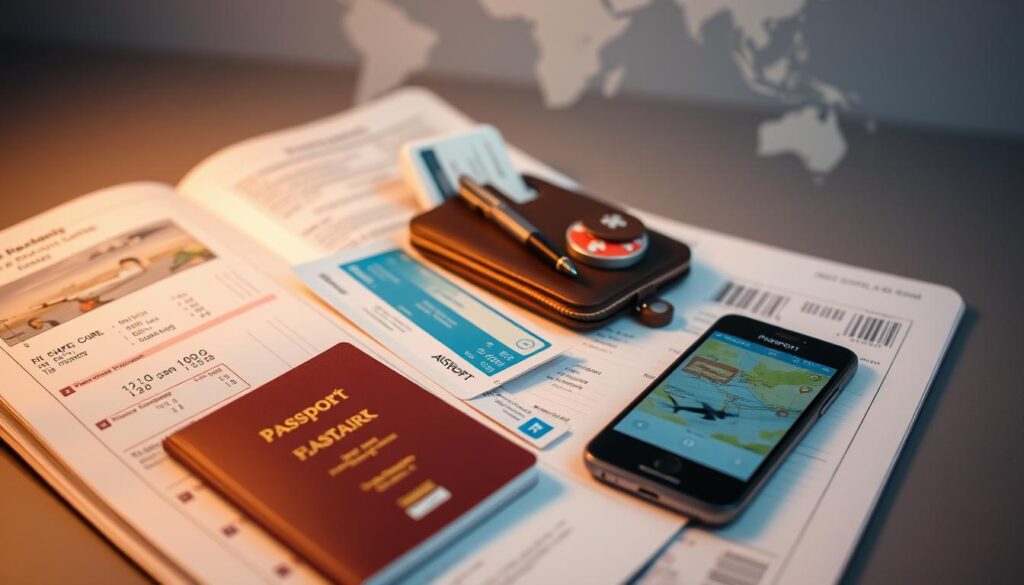I’ll never forget the moment I stepped off a midnight train in Prague, my heart racing as unfamiliar sounds echoed through the empty station. That trip taught me a vital lesson: confidence abroad begins long before you pack your bags. Over 12 countries and countless journeys later, I’ve discovered how small, intentional choices create seamless experiences.
Global exploration has transformed since 2020, with organizations like the World Travel & Tourism Council (WTTC) refining their living protocols alongside WHO and CDC updates. These guidelines act like a compass, helping travelers navigate shifting landscapes while prioritizing well-being. I’ve personally seen how destinations from Tokyo to Tucson implement these standards, creating safer environments without sacrificing wonder.
Through trial and error, I’ve distilled my approach into actionable strategies that blend practicality with joy. You’ll learn how to interpret health advisories like a pro and spot accommodations that go beyond basic cleanliness checklists. Let’s transform anxiety into anticipation, one informed decision at a time.
Key Takeaways
- Preparation builds confidence for smoother journeys
- Global health protocols evolve with current risks
- WTTC frameworks help destinations standardize safety
- Knowledge reduces stress and enhances experiences
- Practical strategies adapt to changing conditions
Introduction to Worry-Free and Safe Travels
My perspective shifted during a solo trip to Iceland when I discovered a café displaying a now-retired global safety certification in its window. That symbol became my gateway to understanding how modern explorers can balance adventure with awareness. Today’s travelers benefit from frameworks developed during recent global challenges, even as priorities continue evolving.
Early initiatives like the Safe Travels program laid groundwork for standardized practices, helping visitors identify locations committed to health protocols. While no longer updated, these efforts taught me to look for visible indicators of preparedness—from sanitation stations to staff training. Researching these markers now forms the first step in my planning process.
I’ve learned that informed choices create freedom. Checking accommodation websites for specific cleaning procedures or vaccination policies takes minutes but pays off in relaxed exploration. Resources like the CDC’s destination pages and airline update hubs offer real-time guidance tailored to current conditions.
What truly makes trips memorable isn’t just the sights—it’s the confidence that comes from knowing you’ve addressed potential hurdles. By blending personal vigilance with industry-developed protocols, we craft experiences where curiosity thrives.
Understanding Global Health and Hygiene Protocols
I realized the power of standardized practices while planning a trip to Costa Rica last year. A hotel manager explained their hygiene protocols with such clarity that I immediately felt at ease. This experience showed me how global frameworks create trust before we even arrive.

WTTC Guidelines Overview
The World Travel & Tourism Council’s health hygiene standards act like a universal playbook. Their living documents cover everything from airport sanitation to tour operator training. What I love is how they merge WHO wisdom with CDC insights—no conflicting advice to decode.
These WTTC protocols update quarterly, which means hotels I visit in Mexico or Japan follow current best practices. I’ve noticed certified spots often have clearer signage and staff who can explain safety measures confidently. It’s like carrying a quality seal in your pocket.
International Standards in Travel Health
Consistency matters when hopping between countries. I look for destinations adopting public health guidelines that match my home country’s rigor. For example, Bali’s adoption of ISO cleanliness standards last year made my decision to visit effortless.
Airports and attractions using these international protocols typically share three traits: visible sanitation stations, staff vaccination rates above 90%, and contingency plans for emergencies. Spotting these markers helps me relax and focus on creating memories instead of managing risks.
The Evolution of Safe Travels Initiatives
My journey through Southeast Asia revealed how crisis responses have matured from chaotic to coordinated. Where I once encountered conflicting mask policies between neighboring countries, I now see airports and hotels sharing standardized protocols. This shift didn’t happen overnight—it took industry associations and governments collaborating to turn reactive measures into sustainable systems.
Early during a health crisis, protocols felt temporary. Today’s frameworks address multiple risk scenarios, from pandemics to natural disasters. The Safe Travels program pioneered this approach, offering toolkits that help businesses implement sanitation stations and emergency communication plans. I’ve watched boutique hotels in Thailand and cruise lines in Alaska adopt these strategies seamlessly.
Three elements define modern preparedness:
| Past Approach | Current Best Practices | Impact |
|---|---|---|
| Reactive policies | Preventive planning | Fewer disruptions |
| Local variations | Global coordination | Consistent expectations |
| Basic hygiene | Tech-driven solutions | Real-time updates |
What excites me most? The private sector’s role in shaping these standards. During recent global events, I’ve seen airlines partner with medical labs to streamline testing and hotels train staff in crisis de-escalation. This evolution means I can focus on cultural immersion rather than contingency planning—the true mark of progress.
WTTC Safe Travels Stamp: Recognition and Benefits
During my recent trip to Lisbon, a small blue-and-white symbol on a hotel lobby window caught my eye—the WTTC Safe Travels stamp. This visual cue immediately told me the property met rigorous global health standards. What began as a crisis response tool has become my trusted shortcut for identifying locations committed to traveler well-being.
Who Can Earn This Badge?
The application process surprised me with its accessibility. Any tourism business—from boutique hotels to tour operators—can use the stamp at no cost after demonstrating compliance. Public destinations like cities or national parks also qualify if they implement WTTC-approved protocols.
| Applicant Type | Key Requirement | Verification Process |
|---|---|---|
| Hotels | Staff training records | Quarterly audits |
| Tour Companies | Equipment sanitation logs | Random inspections |
| Cities | Public space protocols | Third-party certification |
Keeping Standards High
What makes this system work? Ongoing responsibilities for stamp holders. During a Costa Rica visit, a resort manager showed me their daily checklist—12 specific hygiene tasks tracked through digital logs. This accountability gives me confidence that certified locations maintain standards beyond the initial approval.
The real magic happens when businesses showcase their stamp. I’ve noticed certified venues often display it prominently on websites and social media. This transparency helps travelers like me make informed choices while rewarding organizations that prioritize guest safety.
Navigating U.S. Travel Advisories and Risk Levels
A border patrol agent in Tijuana once asked why I carried printed advisory pages—“Smart move,” he nodded. That moment reinforced how U.S. Travel Advisories serve as my first checkpoint when planning trips. These four-tiered alerts help me gauge risks before booking flights or packing bags.

Decoding the Color-Coded System
The State Department’s advisory levels act like a weather forecast for destinations. Level 1 locations feel like sunny skies—I stick to basic precautions like securing valuables. When I see Level 2, I dig deeper into specific concerns, much like checking a storm’s predicted path.
| Level | Action Required | Common Indicators |
|---|---|---|
| 1 | Normal precautions | Low crime (C), stable conditions |
| 2 | Increased caution | Political unrest (U), sporadic crime |
| 3 | Reconsider plans | Terrorism (T), health crises (H) |
| 4 | Avoid travel | Kidnapping (K), armed conflict (O) |
I always check the risk indicators—those single-letter codes explain why a destination gets its rating. A Level 2 with (N) means packing emergency supplies for hurricane season. Level 3 with (D) makes me rethink layovers in certain airports.
Last month, this system helped me pivot from Jamaica (Level 3) to Aruba (Level 1) when crime reports spiked. The advisory updates arrive every Wednesday—I set calendar reminders to review them. Pro tip: destinations with multiple risk codes often require extra contingency planning.
Implementing Safe Travels Protocols for Your Journey
Staring at my boarding pass in Barcelona’s airport, I noticed a small shield icon—my first clue that standardized procedures were in play. This symbol represented more than rules; it signaled a private sector alignment across airlines, hotels, and local businesses. Today, I treat these unified protocols like a roadmap, guiding every step from booking to baggage claim.
My preparation starts with sector-specific checks. For hotels, I review their sanitation schedules. With airlines, I confirm mask policies and air filtration grades. This approach helps me spot gaps before they become problems. Last month in Miami, this vigilance revealed a car rental company using outdated cleaning methods—a dealbreaker I caught early.
Consistency matters most. When protocols align across industries, transitions feel effortless. Imagine landing in Tokyo knowing your shuttle driver, hotel staff, and museum guides all follow the same hygiene standards. That’s the power of coordinated systems.
| Sector | Protocol Focus | My Verification Step |
|---|---|---|
| Aviation | Air quality | Check HEPA filter reports |
| Hotels | Room sanitation | Ask about UV light use |
| Tours | Group size limits | Confirm guide certifications |
I always pack a “protocol kit”—extra masks, portable sanitizer, and digital copies of vaccine records. These items let me adapt when requirements shift mid-trip. During a Lisbon layover last spring, having these supplies helped me breeze through unexpected document checks.
Through trial and error, I’ve learned that destinations embracing these standardized approaches deliver smoother experiences. Their cafes post cleaning schedules visibly. Their transit workers wear protective gear consistently. This attention to detail transforms precaution from burden to peace of mind.
Collaborative Efforts in Crisis Preparedness and Resilience
Attending a tourism summit in Miami last spring, I watched hotel CEOs brainstorm with city officials about flood evacuation routes. This unexpected collaboration showed me how modern crisis preparedness thrives on teamwork. The travel tourism industry now treats challenges like weather disruptions or health scares as shared puzzles rather than isolated problems.

Public and Private Sector Roles
Governments and businesses now co-create solutions I actually notice. During a recent Caribbean cruise, crew members demonstrated emergency drills developed with coast guard input. The private sector brings agility—like airlines creating flexible rebooking tools—while public agencies provide infrastructure support.
WTTC’s partnership playbook helps both sides speak the same language. I’ve seen resorts use their templates to train staff alongside local health departments. Three collaboration wins I appreciate:
- Real-time data sharing during wildfires
- Joint certification programs for tour guides
- Unified messaging during health alerts
Best Practices for a Secure Travel Experience
The best protocols feel invisible until needed. In Costa Rica, my jungle lodge’s evacuation map matched national park signage perfectly. This harmony comes from cross-industry working groups that standardize safety measures without stifling local charm.
Top strategies I now seek out:
| Sector | Initiative | Traveler Benefit |
|---|---|---|
| Hotels | Shared emergency databases | Faster evacuations |
| Airlines | Weather AI partnerships | Smoother rerouting |
| Cities | Visitor alert apps | Real-time updates |
These partnerships prove that safety security isn’t about restrictions—it’s about building networks that let adventures flourish responsibly. When everyone’s rowing in sync, even stormy seas feel navigable.
Integrating Safety and Security in Your Travel Itinerary
Planning my trip to Marrakech last fall taught me a golden rule: security protocols work best when baked into every itinerary detail. I now design trips where safety considerations shape decisions from hotel bookings to walking routes.

My process starts with three non-negotiable checks for each destination:
- Local emergency response times
- Hospital proximity to planned activities
- Public transit crime statistics
For international travel, I allocate 30% more time than Google Maps suggests. This buffer handles unexpected health screenings or security delays without stress. Last month in Rome, this strategy saved me when a metro strike required switching to certified taxi services.
I’ve learned flexibility beats rigid plans. My itineraries now include:
| Original Plan | Backup Option | Trigger Point |
|---|---|---|
| Night market visit | Daytime guided tour | Local advisories |
| Public beach day | Resort pool access | Weather alerts |
Reputable providers make all the difference. I prioritize hotels displaying current safety certifications and tour companies with trained security staff. This approach lets me savor adventures knowing I’ve minimized risks through smart planning.
How I Personally Ensure Safe Travels on International Trips
Crossing into Switzerland last winter, my train screeched to an unexpected halt—a vivid reminder that preparedness turns surprises into stories. My system for international journeys begins six weeks out, blending digital tools with tried-and-true habits.
First step: dissecting my destination’s latest entry rules through official portals. I bookmark embassy websites and set Google alerts for location-specific health updates. Enrolling in STEP ensures real-time notifications if political tensions rise or weather patterns shift.
Documents live in three places—phone wallet, encrypted cloud folder, and a waterproof pouch in my daypack. Medical essentials get equal attention: prescription duplicates, antihistamines, and a compact UV sanitizer nestle beside my passport.
Communication rhythms matter. I share live location access with two trusted contacts and schedule check-ins around time zones. Last month in Bangkok, this practice helped friends guide me to a certified clinic when street food disagreed with me.
Local safety protocols shape every activity choice. I verify tour operators’ certifications through tourism boards and avoid venues without visible cleanliness seals. When instincts ping during a crowded market visit? I pivot to morning hours or guided alternatives.
This layered approach transforms anxiety into agency. By anticipating variables while staying adaptable, I’ve navigated everything from Icelandic blizzards to Moroccan medinas with confidence.
Essential Contact Details and Trusted Resources
My phone buzzed with a flood alert during a New Orleans jazz festival—thanks to the STEP program, I relocated before streets became impassable. This free service from the U.S. State Department delivers real-time updates tailored to your itinerary. I enroll before every trip, pairing it with local emergency apps for layered alerts.
Trusted health resources live in my browser favorites. The CDC’s destination pages and WHO’s outbreak map help me spot trends early. For medical concerns abroad, I bookmark clinics pre-approved by my travel insurance provider.
Three contact details I always carry:
• Embassy phone numbers on waterproof cards
• Hotel manager’s direct line
• Local crisis hotlines in the local language
Digital backups matter too. I store scanned documents in password-protected cloud folders shared with family. When connectivity fails—like during a Tokyo subway outage—printed copies in my daypack become lifesavers.
Local tourism boards often provide the freshest intel. Last month in Barcelona, their WhatsApp channel alerted me to transit strikes before major news outlets. Pair these resources with common sense, and you’ll navigate challenges like a pro.
FAQ
How do I know if a destination follows WTTC health protocols?
I look for the WTTC Safe Travels Stamp on official tourism websites or at airports. Over 300 destinations, like Sri Lanka and the Dominican Republic, use this stamp to show they meet global health standards. You can also check the WTTC’s official list of certified locations.
What’s the first step to apply for the WTTC Safe Travels Stamp?
Start by reviewing the core compliance checklist on WTTC’s site. Businesses, from hotels to tour operators, must prove they follow hygiene protocols aligned with WHO and CDC guidelines. Submitting proof of audits or certifications, like ISO 45001, speeds up approval.
How do U.S. travel advisories impact my trip planning?
I always cross-reference the State Department’s risk levels with local government updates. For example, if a country like North Macedonia has a Level 2 advisory, I check their civil aviation safety reports and entry requirements for testing or vaccination rules.
Can private companies influence travel safety standards?
Absolutely! Airlines like Delta and hospitality groups such as Marriott collaborate with groups like IATA to shape crisis preparedness. I’ve noticed their partnerships often lead to better sanitation practices and real-time health updates for travelers.
How do I add safety measures to my travel itinerary?
I book accommodations with verified hygiene certifications and use apps like TripIt to track COVID-19 entry rules. For tours, I prioritize operators listed under WTTC’s global protocols—many in places like Saudi Arabia now include contactless payment options and emergency contact details upfront.
What trusted resources do you use during health crises?
I rely on the CDC’s travel health notices, the UNWTO’s crisis guidelines, and destination-specific apps like France’s TousAntiCovid. For real-time alerts, the International SOS app helps me avoid areas with sudden outbreaks or security issues.
Why are international health standards inconsistent?
While the WTTC and WHO provide frameworks, local infrastructure and regulations vary. I always verify a country’s civil aviation authority website and look for alignment with global events industry associations to gauge reliability.




